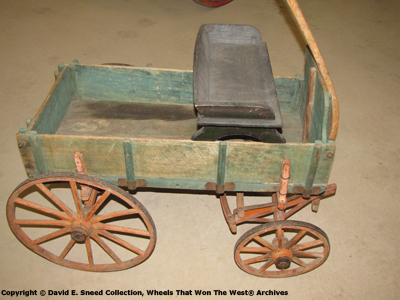When it comes to the fields of marketing and advertising, the basics of these crafts today are amazingly similar to practices employed more than a hundred years ago. Take work vehicles for example. Today, auto makers still tout hauling capacities, craftsmanship, innovation and ruggedness features. Each still purports to have the edge in ease of maintenance, strength and reliability. Plus, the selling dealership still tags his name on the vehicle - a practice started by wagon and carriage makers. Surely competition is no more aggressive than it was for a market glutted with thousands upon thousands of wagon builders during the late 1800s and early 1900s.
Another area of similarity between sales promotions of the different eras is the segment of miniature vehicles. While it's been nearly two decades, I'll never forget how much fun my kids (along with my wife & I while watching) used to have with those battery-powered, ride-in cars and trucks that are still so popular today. Branded with logos from different well-known vehicle companies, these rolling fun machines provide a steady source of income for retailers as well as solid brand exposure for the full-sized sets of wheels they represent... just the way it was done more than a century ago.
Looking back to both sides of the turn of the 20th century, many wagon makers were doing the same thing... reinforcing their brands and lining their pockets with sales from small wagons for kids. Sometimes they were promoted as toys and at other times they were given the added benefit of being helpful around the house, farm, lawn and garden.

Today, surviving examples of these pint-sized creations can command healthy price tags as they're consistently sought-after by collectors and enthusiasts. As with full-size, vintage wagon values, there are a number of elements that help dictate overall prices. (See our "Borrowed Time" book for more details on vehicle values). Of course, as is the case with classic vehicles today, primary brands almost always receive the most attention. Often, that attention alone can result in higher prices.

Perhaps the most commonly seen small wagons like this are the "Studebaker Junior" designs. Heavily promoted beyond the master catalogs, these Studebaker survivors are highly coveted. Just as much in demand are the tiny creations from other legendary wagon makers. So, when we came across this century-plus-old Peter Schuttler child's wagon, we were fascinated by the discovery. While not totally obscure, small wagons like this are far from commonplace today. In fact, rarely does one see a Peter Schuttler brand child's wagon. (I've seen a total of three in thirty years of collecting, travel and research).

While some makers purchased generic, off-the-shelf miniatures from toy wagon makers and applied their logos to them, others manufactured their own. This "baby" Schuttler carries very distinctive wood and metal work that clearly shows a custom design meant to reinforce and complement the legendary Peter Schuttler name... important marketing steps for a big and small world.
